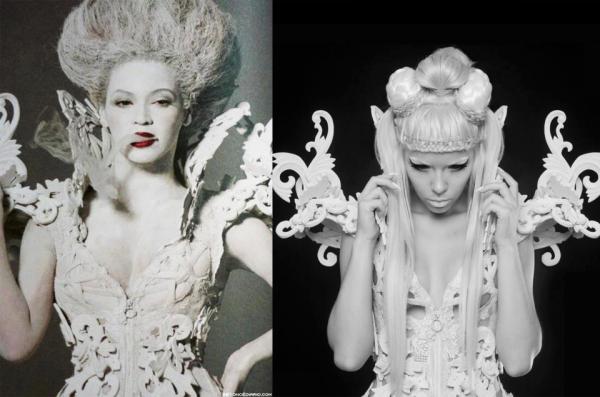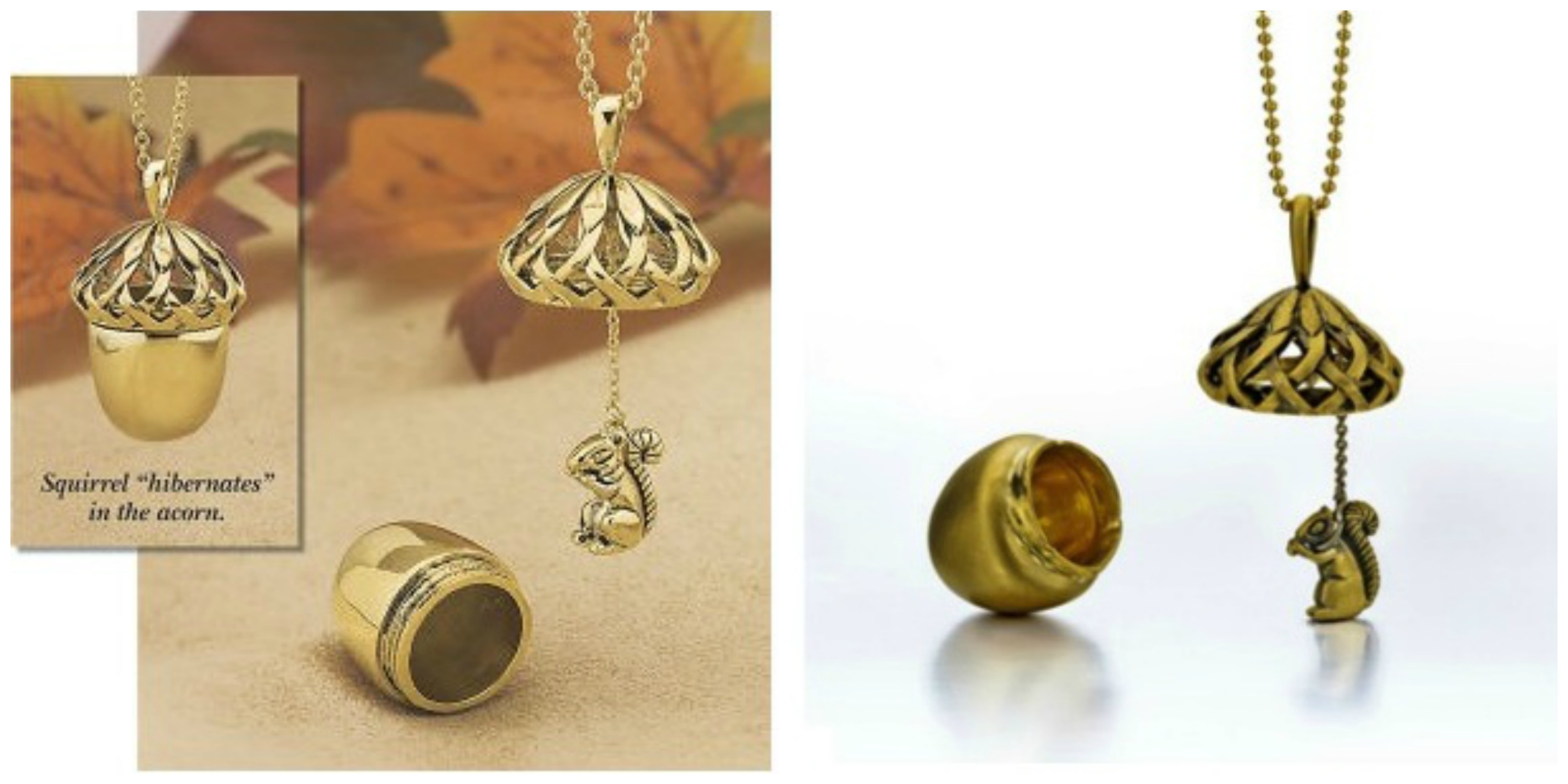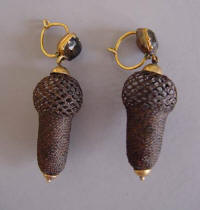I first saw the singer Kerli at Lollapalooza in 2011, and I was very taken by her sound and her alien/anime/Lolita look.
I downloaded her music that night and I’ve kept an eye on her ever since so I was very interested when, this Monday, she posted two photos on Facebook. One was Beyoncé striking a pose in a spray-painted Amato Haute Couture for a just-released tour book; the other was an image of a very similarly styled Kerli wearing the same dress earlier this year.
The day before Kerli posted that, I posted pictures of a costume-jewelry acorn necklace that was strikingly similar to a design I introduced in 2008.
The retailer has since removed the design from its website, and I’m chatting about next steps with the Rhode Island-based factory that produced the piece. Gotta say, I was surprised it was a U.S.-based manufacturer, but I wasn’t so surprised that he suggested that he did his acorn before mine. Maybe we were both studying Victorian mourning jewelry at the same time? Because that’s what inspired me.
In creative fields, people are always taken inspiration from others. (There are also lots of examples of “great minds think alike.“) But at what point does inspiration become imitation? Billboard reviews several examples of Beyoncé’s inspirations while pondering the question in this op-ed piece.
CLICK TO READ THE BILLBOARD ARTICLE.
One line in particular about Beyoncé jumped out at me: “…she’s playing off the risks that other artists have been brave enough to take…” That’s what makes it all so annoying. You take a chance and do something unusual and, once you’ve paved the way, someone else sweeps in and snatches up that idea without having to experience any of the pushback you got. The Billboard article claims that the artists who have inspired Beyoncé have been “appropriately praised for” their original ideas. I wonder if they feel that way. I never feel that way when I’m imitated. I’ve gotten love from my blog readers and my customers — and I greatly appreciate that — but where’s the “appropriate praise” from the stores and mainstream media that could lead to enough sales to keep me in business? The problem with being an underground success is that you’re still underground. In a Wall Street Journal article that I’ve mentioned before, “The Trouble With Being a Trendsetter,” scarf designer Elle Sakellis spoke about how her Otrera evil-eye scarves were knocked off by Raj Imports. She said, “Everyone always says that imitation is the best form of flattery. But it happened too soon. I’m not Louis Vuitton. It’s not like when someone buys a Raj scarf that they know it’s an Otrera knock-off.”
At least Beyoncé’s inspirations get belated recognition if nothing else, because people love to call out Beyoncé and identify her source material. (I do think her Josephine Baker-inspired banana skirt was true inspiration/homage, and not imitation.) By the way, I’m a Beyoncé’ fan and I’m going to see her Brooklyn show in August. She’s got so much going for her; would it be that hard to add a little more originality?
UPDATED TO ADD: I’m happy to say that the manufacturer of the acorn pendant has agreed to pay me a small royalty on sales. I expect it will amount to less than $200 for the year, but I’m pleased to get the recognition.



Well, I think we’d all feel a lot (alot! teehee) more flattered by our imitators if we made more money than they did!
Money is the ultimate compliment.
As a woman with a couple of History degrees, I am interested in the manufacturer’s study of Victorian hair jewelry. It was 30 years ago when I finished my History degrees I had studied political history, military history, and revolutionary history. At that time, where I was, very little social history was studied.
I am thriled to hear of the now common study of Victorian hair jewelry. Wendy, I love the pieces you do because I love history and the extra thought you put into finding and researching historical women. I love your pieces because they are historical, artisitic, and unique.
“I am thriled to hear of the now common study of Victorian hair jewelry. ” — this gave me a good laugh!
Wendy, this is a topic artists don’t talk about enough. It isn’t flattering to have your idea stolen. I’m sorry your designs have been hijacked but I appreciate these posts so much. Things like this are why I’m afraid to put my designs on the web and unfortunately why my business won’t grow in that way.
It’s definitely a tough decision. You need to get your stuff out there but that creates risks. I feel like I rather take the risk and at least a few people will know I did it first 🙂 What I really hate is when I have an idea that I don’t do, then I see other people doing it (in a “great minds think alike” way) and I think … I should have gone ahead and done that!
Best of luck to you!
This is something that’s been worrying me too. I’m so hesitant to put ideas online but I want to grow my business, and like it or not, being an online presence is important. It bugs me no end when people tell me that imitation is the highest form of flattery and I’m glad to hear that I’m not alone in feeling like this. Its hard enough to come up with creative ideas so that it hurts when someone else takes it.
Imitation existed before the Internet … and now the online aspect is necessary for business, so go ahead and get yourself out there! There’s no choice, really. Deal with the consequences as they arise 🙂
I admire your persistence Wendy. Did the manufacturer say where his inspiration came from?
The words “Victorian mourning jewelry” haven’t come up.